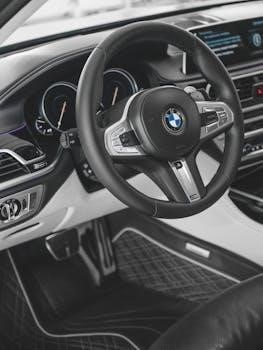
Many modern automatic cars offer a manual mode, allowing drivers to have some control over gear shifts․ This mode often uses paddles or the gear shifter to engage gears․ It allows drivers some control over the driving experience․
What is Manual Mode in an Automatic Transmission?
Manual mode in an automatic transmission is a feature that allows the driver to override the automatic shifting system․ Instead of the car selecting gears automatically, the driver can choose when to shift up or down․ This mode is typically engaged by moving the gear selector to a specific position, often labeled “M” or “+/-“, or by using paddle shifters located behind the steering wheel․ It simulates the experience of driving a manual car, giving the driver more control over the car’s performance․ This mode is not a true manual transmission; it still uses an automatic transmission but allows the driver to have more control over gear selection, and is often found in many modern automatic vehicles․

How Manual Mode Works
In manual mode, the driver uses either paddle shifters or the gear stick to tell the transmission when to shift․ The transmission responds to these inputs, changing gears accordingly․ This provides more control to the driver․
Gear Shifting Methods in Manual Mode
Manual mode in automatic cars offers different ways to shift gears․ One common method involves using the gear shifter itself․ Drivers can usually push or pull the shifter to move up or down through the gears; This method mimics the action of a traditional manual transmission, though without a clutch pedal․ The movement may be quick presses or motions․ Another popular method uses wheel-mounted paddle shifters․ These paddles, located near the steering wheel, allow for convenient and rapid gear changes․ Pulling on the right paddle typically shifts up, while the left paddle shifts down․ The responsiveness and feel of these methods can vary depending on the car’s design and technology․ Both of these methods allow drivers to regain control over the transmission, giving them more input into the driving experience․ This manual method allows the driver to choose which gear to drive in․
Paddle Shifters vs․ Gear Shifter Movement
When using manual mode, drivers often choose between paddle shifters and gear shifter movement for changing gears․ Paddle shifters offer a more convenient method, allowing drivers to keep both hands on the steering wheel․ This can be particularly useful during cornering or when quick gear changes are needed․ Gear shifter movement, on the other hand, requires taking one hand off the wheel, which some drivers may find less convenient․ However, it can offer a more engaging experience, as it involves a more direct interaction with the transmission․ The choice between these methods often comes down to personal preference and driving style․ Some drivers prefer the accessibility of paddle shifters, while others like the more traditional feel of gear shifter movement․ Both approaches allow the driver to have control over the gear changes, allowing more input into the drive․
The Benefits of Using Manual Mode
Manual mode offers increased control over the vehicle’s gear selection․ This can lead to a more engaging and rewarding driving experience․ It allows the driver to choose the gear․
Increased Control Over the Vehicle
Driving in manual mode provides a level of control not found in standard automatic operation․ The driver can choose the specific gear, influencing the car’s acceleration and deceleration․ This is particularly useful in situations where the driver wants to maintain a specific speed or engine RPM․ With the ability to select gears, the driver can optimize the vehicle’s power delivery for different driving conditions, such as climbing hills or when needing to quickly overtake․ Manual mode also allows for engine braking, which can be beneficial in certain situations․ This level of control creates a more engaging driving experience․ It gives drivers a greater sense of connection to their car, making driving more than just transportation․ It allows for more precise maneuvering․
Enhanced Driving Experience
Using manual mode in an automatic car can significantly enhance the driving experience․ It brings an element of engagement that is often missing in standard automatic driving․ The ability to control gear changes provides a more interactive and rewarding feel․ Drivers can feel more connected to the vehicle, enjoying the sensation of mastering gear shifts․ This can lead to a more pleasurable drive, especially for those who enjoy the feeling of a manual transmission․ The driver has better command of the car’s performance․ It allows for a more dynamic driving style, making the journey more enjoyable․ The driver has a more active role in the car’s operation․ It changes the driving experience․

Potential Drawbacks of Manual Mode
While manual mode offers benefits, there are potential drawbacks․ Incorrect gear selection can strain the transmission․ Improper use can cause mechanical damage․ This needs some caution and focus from the driver․
Risk of Incorrect Gear Selection
One of the primary risks associated with using manual mode in an automatic car is the potential for incorrect gear selection․ Unlike a traditional manual transmission where the driver has complete control over the clutch and gear engagement, manual mode in an automatic relies on electronic controls․ This system is designed to prevent catastrophic errors, but it doesn’t eliminate the risk of selecting a gear that’s inappropriate for the current speed or engine RPM․ For example, downshifting too aggressively at high speed can force the engine into an overly high RPM range, potentially causing damage․ Similarly, upshifting too early at low speeds can cause the car to lug and strain․ A driver unfamiliar with the vehicle or lacking experience with manual transmissions may be more prone to these types of errors․ It requires knowledge of the vehicle’s optimal operating range to avoid these situations․ Therefore, while modern systems are designed to protect the car, careful and informed driving is still necessary․
Possible Damage from Improper Use
Improper use of manual mode can lead to potential damage to the vehicle’s transmission and engine․ While modern systems have safeguards, repeated incorrect gear selections or aggressive shifting can still put undue stress on various components․ For instance, constantly downshifting at high speeds to engine brake can cause excessive wear on the transmission, even if the system prevents a catastrophic failure․ Similarly, neglecting to downshift when slowing down can result in the engine lugging and the drivetrain experiencing additional stress․ Furthermore, continuously operating the car at extreme RPM ranges, either too high or too low, can lead to premature engine wear and tear․ Therefore, while manual mode offers a more engaging driving experience, understanding the limitations and proper use is crucial to prevent costly repairs․ It is important to be mindful of the car’s limits and drive accordingly to avoid potential damage․

Manual vs․ Automatic⁚ A Comparison
The choice between manual and automatic transmissions involves trade-offs in control, cost, and convenience․ Manuals offer more driver engagement, while automatics are known for ease of use and often for speed․
Fuel Efficiency Considerations
Traditionally, manual transmissions have been associated with better fuel economy compared to automatics․ This was largely due to their simpler design and direct mechanical connection between the engine and wheels, which minimized power loss․ However, modern automatic transmissions, especially those with multiple gears and advanced electronic controls, have significantly improved their fuel efficiency․ Some automatics, particularly dual-clutch transmissions, can even surpass manual counterparts in fuel economy due to their ability to shift gears more precisely and rapidly than human drivers․ The actual fuel efficiency will depend on driving style, road conditions, and the specific vehicle model․ In manual mode, a driver’s skill in choosing the correct gears is essential for optimizing fuel consumption․ Incorrect gear choices can actually lead to lower fuel efficiency compared to the automatic mode․ Therefore, while manual mode offers potential for better fuel efficiency, it requires an understanding of the engine and the vehicle’s performance․
Performance Differences
In terms of performance, automatic cars, especially those with dual-clutch transmissions, can often outperform their manual counterparts․ This is because automatic transmissions can shift gears much faster and more consistently than a human driver, leading to quicker acceleration times․ However, manual mode in an automatic car can provide a more engaging and responsive driving experience, allowing drivers to hold gears longer and have more direct control over the car’s power delivery․ The performance differences in manual mode often come down to the driver’s skill in selecting the correct gears and their ability to anticipate the road conditions․ While automatics excel in quick acceleration due to fast shifting, manual mode can offer a more rewarding experience for drivers who enjoy controlling the car’s performance․ The performance is dependent on driver skill and the specific car and transmission․

Is Driving in Manual Mode Bad?
Driving in manual mode is not inherently bad, but it requires skill․ It offers more control, but incorrect use can cause damage․ It’s best to use when you want a more engaging drive․
When to Use Manual Mode Effectively
Manual mode can be beneficial in several driving situations․ When descending steep hills, using engine braking by downshifting can provide better control and reduce wear on the brakes․ It is also useful when overtaking other vehicles, allowing you to select the optimal gear for quick acceleration․ In snowy or icy conditions, manual mode can help maintain better traction by giving you the ability to select the right gear, preventing wheel spin․ Furthermore, some drivers use manual mode for a more engaging and fun driving experience on winding roads․ In situations where you want precise engine control, such as merging onto a highway or navigating tricky corners, manual mode provides greater command over the vehicle․ It gives drivers more control and feel․ If you understand the mechanics, this can be a great tool for driving․